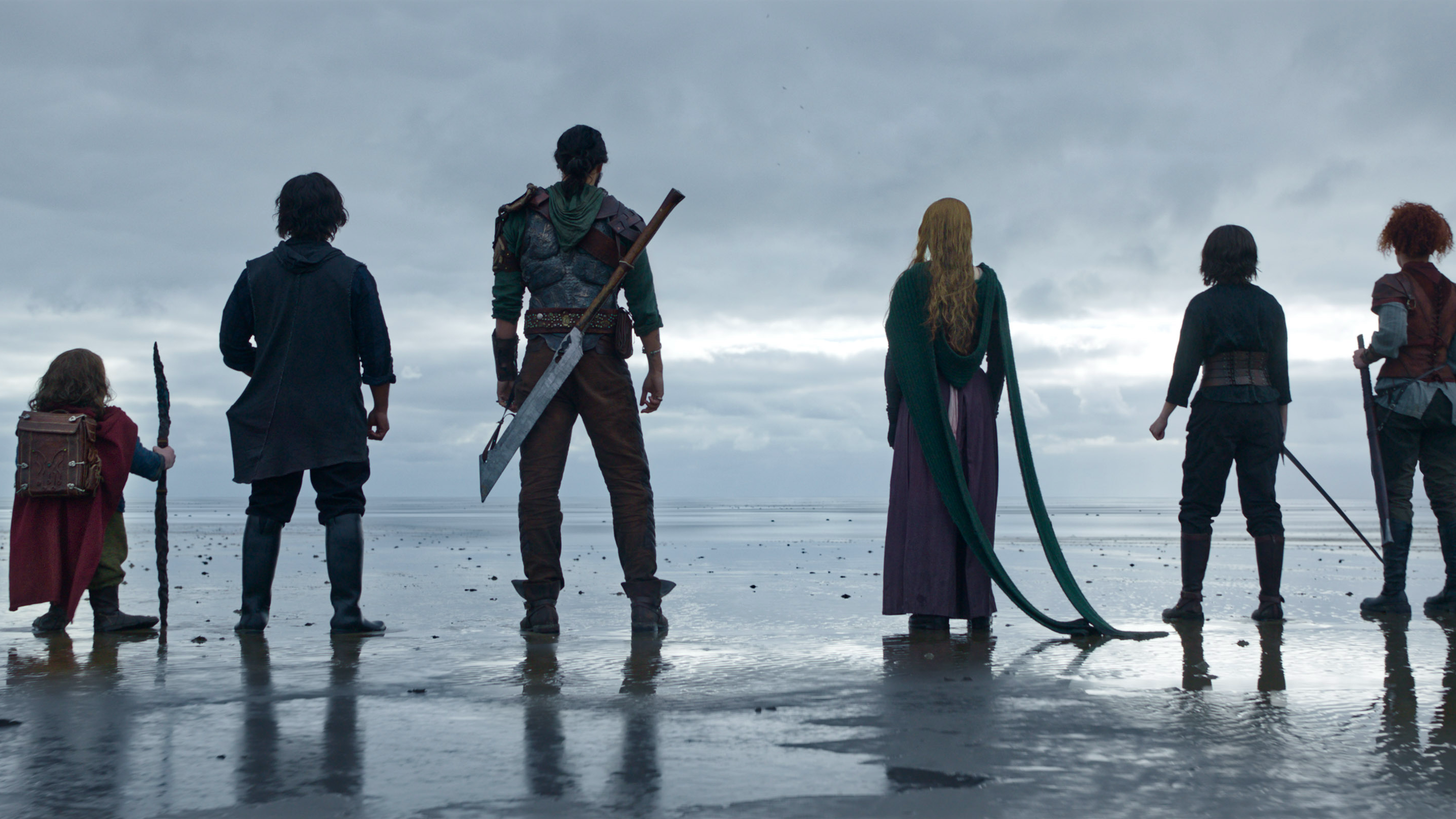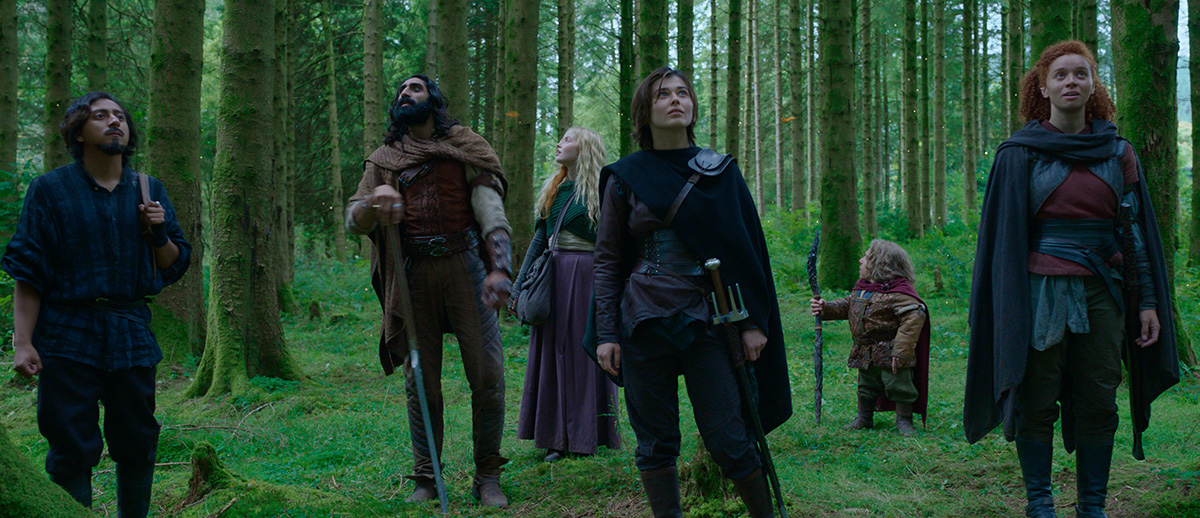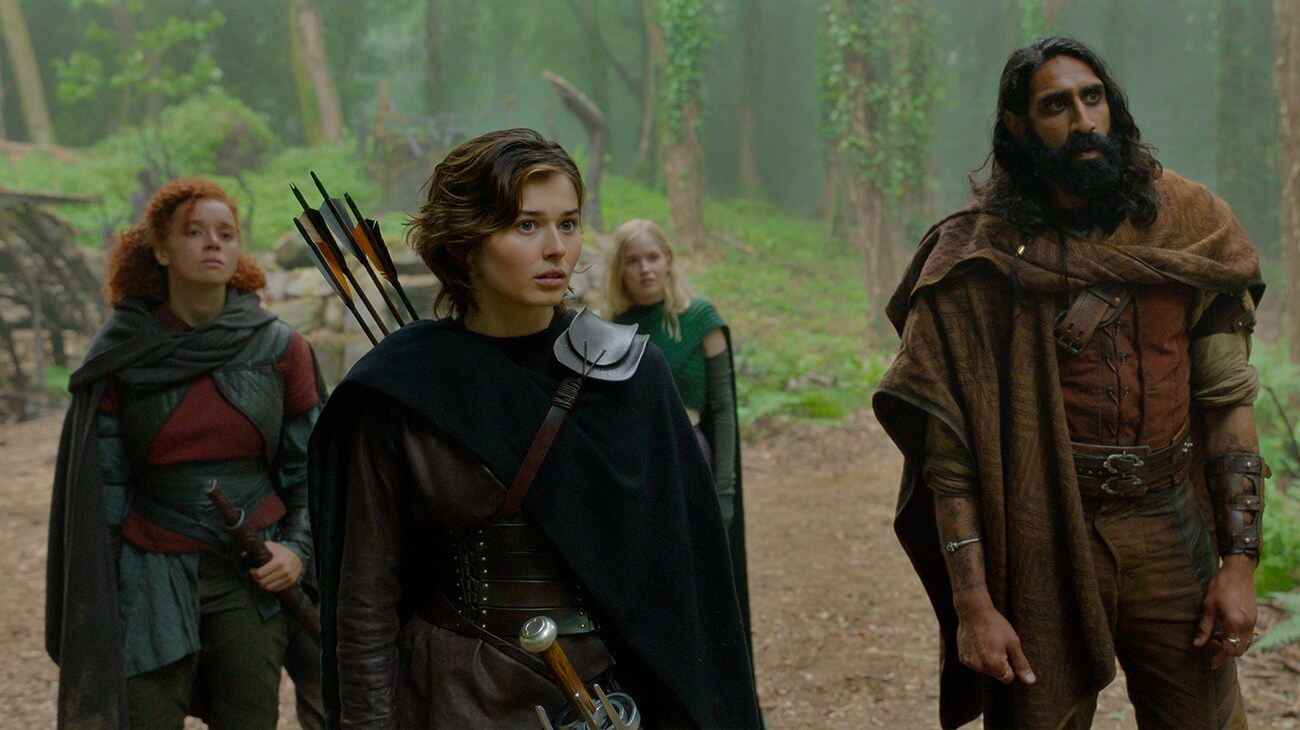Showrunners Jonathan Kasdan and Wendy Mericle on bringing George Lucas’ fantasy story back to life after 34 years.
By Danny Munso
The fact that Jonathan Kasdan ended up on the same film set as Warwick Davis was no accident. As a child, Kasdan fell in love with the world of Willow, the 1988 cult classic Davis headlined that was directed by Ron Howard and produced by George Lucas. As the son of Lucas’ frequent collaborator—screenwriter Lawrence Kasdan—a then 8-year-old Jonathan even attended the fantasy film’s premiere. Years later, the father-son duo were hired to pen Lucasfilm’s Solo: A Star Wars Story, and as he and his dad worked on the script, Jonathan inserted the obscure character of Weazel—portrayed by Davis in a brief onscreen moment in Star Wars: The Phantom Menace—into one scene with the hope that Davis could be in their film. During a down moment on set, Kasdan revealed his real plan to Davis and Howard, who was serendipitously Solo’s director: He planned to convince Lucasfilm and Disney to continue the story of Willow.
For Kasdan, the film left an obvious way into a natural continuation of the story. In the movie, Davis’ Willow is tasked with protecting a baby—Elora Danan (played by twins Ruth and Kate Greenfield)—who will grow up to become a powerful sorceress and bring about the downfall of the evil Queen Bavmorda (Jean Marsh). To Kasdan, that was the beginning of a potentially potent tale. “The idea was about how do we continue the story of this girl, and how do we make it about her education in magic in a meaningful way,” he says. “It felt like it could be sort of a little more grown-up Harry Potter, where you skip the more adolescent part of that story, where it’s about dealing with her emotions and controlling them. Here was this baby with all this potential who would have to figure out how to channel it and figure out how to use it for productive ends and not destructive ends. It felt in line, to me, with a lot of the George Lucas stuff. The movie provided a great setup for that.”
Kasdan’s dream became a reality when Disney announced plans for its Disney+ streamer, and Lucasfilm was asked to deliver television shows for the new streaming service. Kasdan’s follow-up to Willow would be one of them, with Davis back in the title role and Howard on board as an executive producer. The creator got to work by himself, first penning a series bible that detailed the story and characters and then a pilot episode that sets those events in motion. In that first episode, we find the land of Tir Asleen under the peaceful rule of Queen Sorsha (Joanne Whalley, reprising her role from the film). Elora is still alive, but Sorsha and her now absent husband, Madmartigan (played by Val Kilmer in the film—much more on him later), decided to hide her identity and allow her to grow up without the knowledge of what she is destined to become. On the eve of the wedding of Sorsha and Madmartigan’s daughter, Princess Kit (Ruby Cruz), the castle is attacked by mysterious dark forces known as the Gales, who kidnap Kit’s twin brother, Airk (Dempsey Bryk). With Sorsha’s blessing, Kit leads a party—including her best friend and knight-in-training Jade (Erin Kellyman); the softspoken man she is supposed to marry, Graydon (Tony Revolori); and her father’s disgraced former squire, Boorman (Amar Chadha-Patel) to track down the land’s last sorcerer, Willow Ufgood, and aid them in their quest to rescue Airk.

Along the way, they realize they have secretly been joined by Dove (Ellie Bamber), the young castle kitchen maid who is in love with Airk and wants to help. When they reach Willow, he not only agrees to lead them on their journey but reveals Dove’s true identity: She is Elora Danan. When Kasdan convened his writers’ room in early 2020, just before the pandemic hit, he brought quite a bit of the story with him. “The characters were sort of established and their voices were there—a certain amount of the journey as well,” he says. “So the shape always existed. When we got in the room, it was about filling out and building out the adventure and relationships in a meaningful way. I recently went back and looked at what was in the bible, and in a lot of ways, the season really did fulfill the promise of that.” The first few months of the writers’ room were derailed by the pandemic as the writers adapted to working virtually. After a few episodes had been broken and written, Lucasfilm VP of live-action series development Max Taylor called longtime TV scribe Wendy Mericle and invited her to join the series as a writer and exec producer.
In demand for 20 years, Mericle was coming off showrunning the CW’s long-running series Arrow, but her roots with Lucasfilm go as far back as 2009, when she penned a season-two episode of the animated Star Wars show The Clone Wars. “I have been a longtime Star Wars fan,” Mericle says. “When I first signed a deal with Disney in 2018, I went over there and met with everyone at Lucasfilm. I had such a great time doing The Clone Wars years before and wanted to keep working for Kathy Kennedy and all the amazing people at the company.” At the time Willow was being written, it was still incredibly early in Lucasfilm’s experience with live-action television. To that point, only The Mandalorian had premiered, and that is mostly penned by creator Jon Favreau and not run like a traditional series from a writing standpoint. Taylor thought Mericle’s steady hand would help see the writers’ room through to the end and be invaluable during production. “There was a really clear sense visually of what Jon [Kasdan)] wanted the series to be. I think he and Lucasfilm had been going back and forth a fair amount of where some of the characters were and where the endgame was in terms of the finale. Having this be one of their first forays into scripted television, I think there was a real desire to have the whole picture mapped out.”
Kasdan and Mericle were aided in the room by the presence of Bob Dolman, the screenwriter of the original Willow. Dolman had been on sabbatical from screenwriting, instead turning his energies to painting—read Backstory’s interview with Dolman in this same issue—but returned at Kasdan’s request to help them craft the story for Willow’s next chapter. “What I was really looking forward to with him is retaining the sound of the character of Willow in a way that felt like it was nicely balanced against Elora, whose voice I thought I had a strong sense of,” Kasdan notes. There is a hilarious scene in the show’s second episode where Willow is struggling to teach a simple spell to Elora, who keeps botching it. Kasdan says this is not unlike his relationship with Dolman, who was trying to impart his own knowledge on the younger Kasdan. “In our conversations, there were echoes of the Willow and Elora relationship. Bob’s humor and openness and spirituality and my combination of doubt and eagerness and enthusiasm played out in the room as well as on the page. We had a fun time.”

Throughout the film, it is Willow’s desire to become a great sorcerer. In the movie’s climactic moment, he defeats Bavmorda not with actual magic but with a sleight-of-hand trick where he makes Elora temporarily disappear. This stuns Bavmorda, who makes a mistake and ends up sealing her own fate with the spell she was intending to use to destroy Elora. In the series’ second episode, the writers choose to flash back to a moment between the film and the main events in the show, where Willow shows up to Tir Asleen to inform Sorsha that the young Elora needs to begin her training to become a sorceress. Sorsha has already hidden Elora’s true identity from everyone else and vehemently disagrees with her old friend, instead insisting that Elora grow up a normal child. After Willow persists, Sorsha gets angry and tells Willow that though he is brave, he is not a real sorcerer so he shouldn’t be training Elora anyway. Willow takes this personally and vows never to return to Tir Asleen.
These crucial and shocking flashes to the characters’ falling-out were something Kasdan fought to keep in the show. “We had to understand what could come between them,” he says. “I loved the idea that they both care deeply for this child but have very different ideas for how to handle her growing up. That felt sincere and nice, where you could empathize with both of them but also see how they were in conflict. In the aftermath of the success [and the end of the movie], he’s had an experience like a lot of filmmakers I know where success often leads to a certain arrogance and a sense that your powers are perhaps greater than they actually are. That’s what she’s trying to say, and she just says it in a particularly brutal way.” As viewers of the series know, Willow’s magic has grown substantially since the movie. After Sorsha’s dismissive comments, he has turned into something of the sorcerer he always thought he would become, albeit just a little older and with far less stamina.
Another crucial piece of Willow’s backstory is put in place in the show’s fourth episode, which reveals the actual circumstances of Bavmorda’s fall are not widely known. The greater population believes Willow genuinely defeated the witch with a powerful spell and because she was present when it happened, Sorsha is the only surviving person who knows the actual truth. Episode four sees the group visit Nockmaar, Bavmorda’s abandoned castle, and the characters wind up in the same tower where she was defeated all those years ago. It’s here that Willow admits to Elora and the others what actually happened. “He’s embarrassed he sort of stumbled into his greatest achievement ever,” Kasdan notes. The scene is one of the best in the series’ first half, not just for Willow’s confession. Because of the magic imbued in the castle, Elora is allowed to see herself as a baby and how she was saved. To Kasdan, the climactic scene in the film was always about Elora, and he felt compelled to revisit it in this moment. “What I always interpreted in that scene as was it was the prophecy of Elora coming true. These characters, and specifically the men in the Willow story, were the instruments of fate. Willow was in the right place at the right time for Bavmorda to bring about exactly what she was trying to avoid.”

With Bavmorda dead, Kasdan had to invent a new series of villains for the series, and for this he took an interesting tack. Rather than have a singular figure, he desired a more complex—and mysterious—mythology with which to play around. There are the creatures known as the Gales, who kidnap Airk. They serve their shadowy master, the Crone, who is kept offscreen for much of the series and seems destined to square off against Elora at some point—unless the Crone is serving a different being altogether, which the series’ early episodes may or may not hint at. It’s all a little vague, particularly at this point in the series—whose episodes roll out through Jan. 11—but keeping the greater evil mostly offscreen is not dissimilar to how Dolman dispatched Bavmorda’s scenes in the film. Kasdan also likens it to a different George Lucas series. “I like the way the emperor is handled in the original Star Wars trilogy,” he says. “He felt so big and bad and just felt powerful to me. I like the idea of keeping the darkness in the shadows. I’ve always been attracted to the idea of these cosmic evils, these sort of Lovecraftian nightmares. What they represent beyond just a scary, giant monster is sort of a universe indifferent to your sense of right and wrong and good evil. It’s bigger than that.”
The writers ask a lot of the audience in terms of tracking the exact evil, and finding the right balance of explanation versus overexplanation was something that continued throughout the breaking of the first season. Mericle notes this was a point of contention between her and Kasdan, as she had come from the world of superhero storytelling, where a well-defined and fleshed-out villain is necessary. “We did a lot of back and forth about how complicated to make this,” she says. “Jon wanted it to be a very complex, nuanced, interesting set of bad guys, and I was coming at it more from just having one person and making it less complex and have that person be really dynamic and interesting. I think with that push and pull between the two of us coming from two different points of view, we got to a good middle ground. I think he got a lot of the stuff he wanted in there, but hopefully we allowed it to be streamlined enough so the audience could wrap their heads around exactly what was happening.”
The reason it all works as well as it does in the series is down to how the writers structured the season. Each episode is set in a very different location, and each of those contains its own evil, which our heroes must battle. The initial set of episodes sees the Gales infect one of Tir Asleen’s knights, Commander Ballantine (Ralph Ineson), and the group is forced to fend off his efforts to kidnap Elora. The fourth episode is their visit to Nockmaar, where the castle’s magic presents its own obstacle for the characters. That is the case going forward, and a clearer picture of the season’s central villain begins to form. “One of the things I really loved about Jon’s conception for the series was that every episode was basically a stand-alone,” Mericle says. “It was a new location every time. It’s challenging from a story perspective, and it’s also incredibly fun. You really are writing a movie every week, and that allows you to keep the urgency up, and giving our villains new locations and new opportunities to attack our heroes was part of that.”

Much has been made about the prospective involvement of Val Kilmer in the series—and understandably so. For the uninitiated, Kilmer has had difficulty speaking due to a battle with throat cancer, yet if his acclaimed (and wordless) appearance in this year’s Top Gun: Maverick is any indication, he still very much acts. One thing is certain: Kilmer loves Willow. He and Davis did a memorable spoof of themselves in the final episode of Davis’ BBC/HBO series Life’s Too Short, where the two try to get a Willow sequel off the ground. And of course, Willow was the film where he met ex-wife Whalley, the mother of his two children with whom he is still close. Despite his vocal limitations, Kilmer was indeed set to reprise his iconic role as Madmartigan late in the series, but pandemic-related travel complications—the series was filmed in Wales—put an end to that. This landed the writers in a bit of a pickle as scripts were penned assuming the actor’s involvement. Their solution was an elegant one that kept Madmartigan’s importance to the story intact and kept the character alive for any possible future iterations. It also led the writers to create an entirely new character that will be played by Christian Slater. It’s an old cohort of Madmartigan, whose presence is felt in major ways throughout the story, particularly through Kit, who struggles to understand why her father seemingly abandoned her family in order to carry out a task meant to protect Elora. “He is still with us in the series,” Kasdan says. “We wanted to see him, but obviously it was too challenging. As long as he’s [still] with us, we’re hoping to get him in there. He is a big part of all this.” Kilmer clearly feels the same way, as the actor has been posting photos to his social media throughout the show’s run, ranging from a shot of Kasdan and Davis together to old photos from the shoot accompanied by words expressing his enjoyment of the series and his love for those involved.
If Kilmer appears in future Willow episodes, that will mean Disney sees the show’s inaugural season as enough of a success to okay another one. That hasn’t happened at the time of this writing, but Kasdan isn’t waiting for the official greenlight. As he is speaking to Backstory, he’s in his office coming up with ideas for a season two just in case. “The hope of trying to do more has driven the last couple months of my life,” he says. “It’s been fun working with Disney. I would love to do more, and I think the actors would, too. I’m the least objective person in the world, but I do think the episodes get even better from here on out. I’m excited for people to get more involved in the story.”
Willow is streaming now on Disney+!
If you’d like to subscribe – feel free to use coupon code: SAVE5 to take $5 off your subscription and get instant access!
All you need to do is click here to subscribe!
There’s plenty more to explore in Backstory Magazine issue 48 you can see our table of contents right here.
Thanks as always for spreading the word and your support!